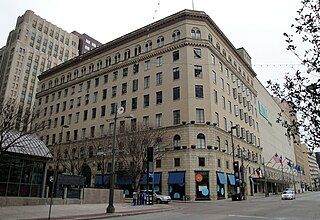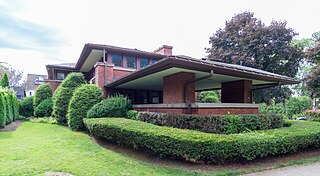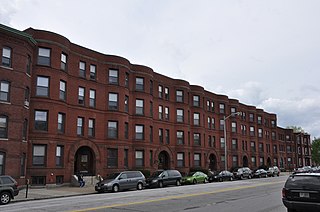
The Old State House, also known as the Old Provincial State House, is a historic building in Boston, Massachusetts, built in 1713. It was the seat of the Massachusetts General Court until 1798. It is located at the intersection of Washington and State Streets and is one of the oldest public buildings in the United States.

The Cathedral of Saint Paul — informally known as Saint Paul's Cathedral — is the mother church of the Roman Catholic Diocese of Worcester. It is located at 38 Chatham Street in downtown Worcester, Massachusetts. Built between 1868 and 1889, it is one of the city's finest examples of Victorian Gothic architecture, and was listed on the National Register of Historic Places in 1980.

The William Lloyd Garrison House, also known as Rockledge, is a National Historic Landmark house, located at 125 Highland Street in the Roxbury Highlands section of Boston, Massachusetts. Probably built in the 1840s or 1850s, it is significant as the longtime home of William Lloyd Garrison (1805–1879), one of the most high-profile abolitionist activists of the mid-19th century United States. Garrison published The Liberator, the principal organ of the abolitionist movement, and spoke for the immediate emancipation of slaves. Despite significant later alterations to accommodate institutional uses, the building has retained much of its 19th-century fabric. It was designated a National Historic Landmark in 1965 and is a pending Boston Landmark.

The Titche–Goettinger Building is one of Dallas' original broad-front department stores located along St. Paul Street between Main and Elm Street in downtown Dallas, Texas (USA). The structure currently houses apartments, retail space, and the Universities Center at Dallas. It is listed on the National Register of Historic Places both individually and as a contributing property in the Dallas Downtown Historic District and is a Dallas Landmark as part of the Harwood Street Historic District. It is also located across the street from Main Street Garden Park.

The Dupee Estate, located at 400 Beacon Street in the village of Chestnut Hill, Newton, Massachusetts, was the last home of Mary Baker Eddy, the founder of Christian Science.

The Abbott Street School is a historic school building at 36 Abbott Street in Worcester, Massachusetts. Built in 1894, it is a good local example of Romanesque Revival architecture. It served as a public school until 1981, after which it was converted to residential use. The building was listed on the National Register of Historic Places in 1980.

Liberty Farm is a National Historic Landmark at 116 Mower Street in Worcester, Massachusetts. Built c. 1810, it was the home for most of their married life of Abby Kelley Foster (1810–1887) and Stephen Symonds Foster (1809-1881), early vocal abolitionists and women's rights activists. The Fosters used their house as a shelter on the Underground Railroad, and famously refused to pay taxes on the property because Abby was unable to vote. The property, a private residence not open to the public, was designated a National Historic Landmark in 1974. In 2018 the building was sold off to a local family.

Charles Street African Methodist Episcopal Church is an historic African Methodist Episcopal Church at 551 Warren Street in Boston, Massachusetts. The current church building was built in 1888 by J. Williams Beal and added to the National Register of Historic Places in 1983.

The Sarah J. Baker School is an historic school building in Boston, Massachusetts. Built in 1905 by a prominent local architect, it is a well-preserved example of early 20th-century Romanesque Revival school architecture. The building was listed on the National Register of Historic Places in 1983, and was included in the Moreland Street Historic District in 1984. It has been converted to elderly housing.

The D. E. Makepeace Company is a historic industrial building at 46 Pine Street in Attleboro, Massachusetts. Built in 1899-1900, it is one of the city's best examples of a jewelry factory building of the period. The Makepeace Company was a major contributor to the city's reputation at the turn of the 20th century as America's jewelry capital. The building, now converted to residences, was listed on the National Register of Historic Places in 1985.

The Hopewell School is a historic school building located on Monroe Street in Taunton, Massachusetts. It was built in 1914, and designed by the Boston firm of Kilham & Hopkins in the Renaissance Revival style. The school replaced a previous school of the same name located around the corner on Bay Street in the Whittenton section of the city.

The Brown Square House, now the Garrison Inn, is a historic pair of rowhouses at 11 Brown Square in Newburyport, Massachusetts. Built in 1809–10, they form the largest surviving brick building from the Federal period in the city. The building was added to the National Register of Historic Places in 1975, and included in the Newburyport Historic District in 1984.

The William R. Heath House was designed by Frank Lloyd Wright, built from 1903 to 1905, and is located at 76 Soldiers Place in Buffalo, New York. It is built in the Prairie School architectural style. It is a contributing property in the Elmwood Historic District–East historic district and a City of Buffalo landmark.

The former Downing Street School, now the Traina Center for the Arts of Clark University, is a historic school building at 92 Downing Street in Worcester, Massachusetts. Built in 1891 to a design by Boston-based architect William Forbush, it is a high-quality local example of Romanesque Revival architecture. The building was listed on the National Register of Historic Places in 1980.

The Malvern Road School is a historic school building on Malvern Road and Southbridge Street in Worcester, Massachusetts. Built in 1896 and enlarged in 1907, it is a high quality example of Beaux Arts and Renaissance Revival architecture. It is also significant as a well-preserved work of the local architectural firm Fuller & Delano. The building was listed on the National Register of Historic Places in 1984. The building has been converted to residential condominiums.

The Basilica and Shrine of Our Lady of Perpetual Help informally known as The Mission Church is a Roman Catholic basilica in the Mission Hill neighborhood of Boston, Massachusetts, United States. The Redemptorists priests of the Baltimore Province have ministered to the parish since the church was first opened in 1870. The shrine is dedicated to the Blessed Virgin Mary under the title of Our Mother of Perpetual Help.

The Glenville School is a historic school building at 449 Pemberwick Road in the Glenville section of Greenwich, Connecticut, United States. It was listed on the National Register of Historic Places in 2003. It was one of several schools built in the town in the 1920s, when it consolidated its former rural school districts into a modern school system, with modern buildings.

The Smith and Dow Block is a historic apartment house at 1426-70 Elm Street in Manchester, New Hampshire. When built in 1892, this four-story brick building was the largest apartment block in the state, and it still dominates its section of Elm Street. It has modest Romanesque styling elements, and was designed by William M. Butterfield, one of Manchester's leading architects, as an investment property for John Butler Smith and Frederick C. Dow. The building was listed on the National Register of Historic Places in 2002.

The Edward Sewall Garrison is a historic house at 16 Epping Road in Exeter, New Hampshire. With a construction history dating to 1676, it is one of New Hampshire's oldest buildings, and is a rare example of a formerly fortified garrison house in its original location. The house was listed on the National Register of Historic Places in 1980.

The Benjamin Silverman Apartments are a historic multifamily residential building at 50-52 Lorne Street and 4 Wilson Street in the Dorchester neighborhood of Boston, Massachusetts. Built in 1915, it is a good example of period Colonial Revival architecture, built during a major period of Jewish migration to the neighborhood. The building was listed on the National Register of Historic Places in 2018.
























